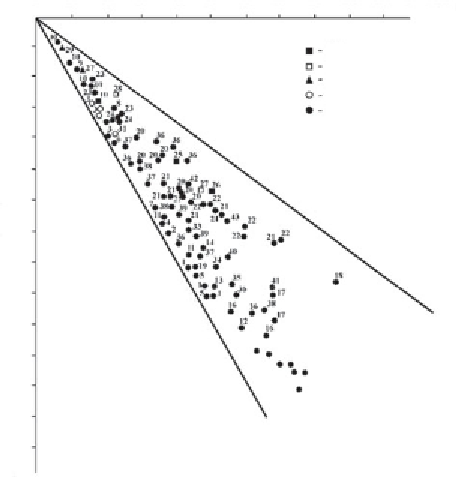Geology Reference
In-Depth Information
0
0
0
0
0
0
0
0
0
0
0
P
II.I
, M
Π
a
500
1000
Jurassic
Lower crfetaceous
Upper cretaceous
Paleocene-miocene
Pliocene
1500
2000
2500
3000
3500
4000
4500
5000
5500
6000
6500
7000
H
,
M
Figure 3.1
Initial formation pressure in South Caspian Depression waterhead complexes
.
Fields:
1.
Karadagh,
2,
Lokbatan (south flank),
3.
Lokbatan-Puta.
4.
Kushkhana,
5,
Zyrya,
6.
Surakhany,
7.
Peschany Isl.,
8.
Zhiloy Isl.,
9.
Gryazevaya Sopka,
10.
Netyanye
Kamni,
11.
28 April,
12.
Sangachaly-More,
13.
Duvanny-More,
14.
Bulla Isl.,
15.
Bulla-
More,
16.
Garasu,
17.
Sangi-Mugan,
18.
Persiyanina Stone,
19.
Khamadagh-More,
20.
Kyurovdagh,
21.
Karabagly,
22.
Kyursangya,
23.
Mishovdagh,
24.
Kalmas,
25.
Keshchay,
26.
Begimdagh-Tegchay,
27.
Gyadysu,
28.
Sobetabad,
29.
W. Agburun,
30.
Umbaki,
31.
Ajiveli,
32.
Ragim,
33.
Livanov Bank East.,
34.
LAM Bank,
35.
Zhdanov Bank,
36.
Cheleken,
37.
Nebitdagh,
38.
Kotur-Tepe,
39.
Barsagelmes,
40.
Burun,
41.
Kyzylkum,
42.
Kum-Dagh,
43.
Kamyshlja,
44.
Sabail,
45.
Gozel-Tepekh.
display any AHPP. However, recorded there are significant excess formation
pressure and abnormality factors. They appear to be a result mostly of two
reasons. The first one is unrelaxed syngenetic AHFP that emerged in rather
enclosed reservoir volumes due to their own gravity compression and pen-
etration into them of pore solutions. Simultaneously “regenerated” waters
generated in the transformation process of thick montmorillonite clay series
into hydro-micaceous aggregates penetrated the reservoirs. This transforma-
tion of montmorillonite clays was accompanied by the release of additional
pore water. In other words, additional water emerging in the montmorillon-
ite to hydro-mica conversion increased the pressure in a reservoir.

